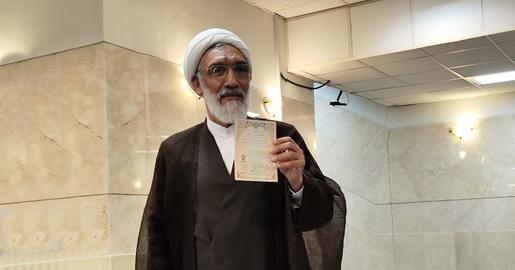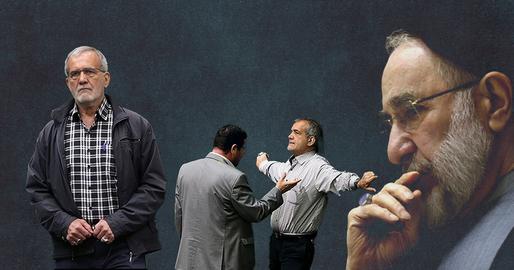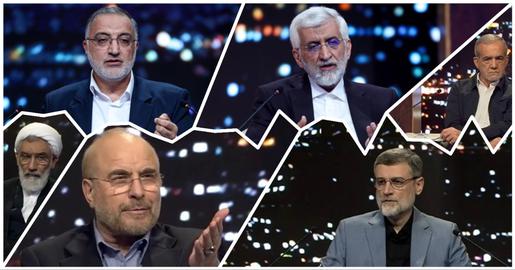Mohammad Bagher Ghalibaf, the Speaker of the Parliament and candidate for the snap presidential election, appeared on the special news program of state TV on Tuesday to discuss his economic plans.
During the program, he explained the process of approving the law for the 7th Development Plan and outlined his economic plans for the upcoming presidential term.
He presented false and misleading statistics and promised that, by the end of his government, the country would witness economic stability, curbed inflation, increased purchasing power, stability in the stock market and currency exchange rate, decreased housing prices, increased productivity, and a stabilized economic growth rate at 8 per cent.
Investigations by IranWire reveal that much of the information and statistics provided by Ghalibaf are not based on reality.
First: I Will Increase the Timing of Access to Housing from 13-14 Years to 7.5 Years
Ghalibaf claimed: "The index of access to housing is currently 13-14 years, and I will increase it to 7.5 years."
He explained that the timing of access to housing means that if a worker saves their entire annual income for housing, after 13 to 14 years, they can own a residential unit.
He promised to reduce this period to 7.5 years.
Is the index of access to housing in Iran currently 13-14 years? Can a worker buy a 75-meter residential unit if they save their entire income for 13 years? The answer is no.
The minimum monthly salary of workers in 2024 is 12 million Tomans ($206). If a worker saves this entire income, they will have 144 million Tomans ($2,482) at the end of the year.
According to the Tehran Real Estate Association, the average price per square meter of a residential unit in Tehran is 81 million Tomans ($1,396). This means that an annual worker's savings can buy less than 2 square meters.
Given that a standard residential unit is 75 square meters, it would take more than 40 years for a worker to afford such a unit.
Thus, no worker can buy a residential unit with 13-14 years of income.
Therefore, reducing the timing of access to housing in a five-year process to 7.5 years is also unrealistic and an unfounded promise.
In November 2023, Alborz Hosseini, the representative of the Khodabandeh people in the parliament, told ISNA: "Targeting 7.5 years for access to housing is far from reality. Considering the conditions of the country, we in the parliament increased this number to 12.5 years, which even the members of parliament did not accept given the country's economic index.
"It was decided to adjust this number to a more reasonable figure. For example, a person with a monthly income of 12 million Tomans, if they do not spend any of it, will have an annual income of 130 to 140 million Tomans.
"If this person wants to buy a 75-meter house in Tehran in a middle-class neighborhood, they need to pay about 6-7 billion Tomans ($103,488 - $120,689). If they have no expenses, the average access to housing for this person would be around 60 years."
Therefore, it is clear that both the claim that the timing of access to housing in Iran is 13-14 years and the promise to reduce it to 7.5 years is baseless.
Second: The Average Economic Growth Rate in the 2010s Was Less Than 1%, Which I Will Increase to 8%
Ghalibaf claimed: "The average economic growth rate in the 2010s was less than 1 per cent, which I will increase to 8 per cent."
Investigations by IranWire show that economic growth in the 2010s experienced significant fluctuations.
At the beginning and end of the decade, economic growth was negative due to intensified oil and banking sanctions and the spread of the coronavirus.
However, in the mid-2010s, economic growth in Iran exceeded 14 per cent with the signing of the nuclear deal in 2015 and an increase in foreign investment, a rare record for the country.
This growth was short-lived due to the unilateral withdrawal of the United States from the deal under President Donald Trump and the re-imposition of extensive oil sanctions.
Ignoring these key factors that impacted economic growth in the 2010s, including the US's withdrawal from the deal and the global pandemic, presents a misleading picture of Iran's economic situation during that decade.
Additionally, the recent economic growth observed in the last three years has been primarily due to increased oil sales.
A report by the Fakt-Nameh website on the quality of Iran's economic growth in 2023 noted: "None of the four indicators - Capital Formation, Employment, Non-Oil Exports, and Foreign Investment - experienced significant change. The increase in the share of oil in Iran's economy has caused an increase in the rate of economic growth."
Furthermore, the upcoming presidential elections in the United States and the possibility of Donald Trump's return could lead to the re-imposition of more oil sanctions and a sharp decrease in Iran's economic growth rate.
Therefore, Ghalibaf's claim to raise the economic growth rate to 8 per cent overlooks the complexities and external factors that significantly influence Iran's economy.
Third: I Will Achieve 2.7% of Increase in the Economic Growth Rate by Increasing Productivity
Ghalibaf claimed: "I will achieve 2.7 per cent of the increase in the economic growth rate by increasing productivity."
This claim is completely misleading because there is no evidence of a significant effect of the productivity rate on the economic growth rate.
Eco Iran, in a report entitled "How Much of Iran's Economic Growth is Due to Productivity Growth?" questioned the National Productivity Organization's claim that productivity had a 75 per cent impact on Iran's 6.2 per cent economic growth in the spring of 2023.
The report stated: "The published statistics on productivity show that the growth rate of productivity in the last three years has been positive but declining. A closer look at the calculations shows that the calculated rate was obtained by calculating the growth rate of the per capita production index of production inputs in the economy.
"In this way, the effect of the physical increase of capital and labor is simplified and any increase in production is considered to be due to the improvement of labor productivity."
This method of calculation can be misleading, as an increase in an economy's output may be due to improved trade relations or lower prices.
In this case, the increase in production is not due to the increase in the skill and ability of the labor force or the physical increase in production inputs, and it is strengthened from another source.
For example, in recent years, the production of the oil and gas sector has faced a significant increase. For this reason, changes in per capita production cannot necessarily indicate productivity growth.
Fourth: We Have 12 Million Taxpayers and 4-5 Million Tax Evaders
Ghalibaf claimed: "We have 12 million taxpayers. Of these, 9 million have come and completed the files, and 5 million people can get tax exemption if they come and enter the information."
Regardless of the incorrect additions and subtractions, this statistic has no relation to reality.
According to the Tax Affairs Organization report, the number of taxpayers has grown by 83 per cent over the past two years, reaching a total of 5,350,000 people in 2023. This means that a large part of taxpayers who were on the list of tax evaders have been identified.
However, there are no statistics on the number of individuals and companies that should file as taxpayers with the Tax Affairs Organization but have not done so.
Considering that the total number of taxpayers is about 5 million, the number of evaders cannot be 5 million people.
Fifth: 50% of Energy Resources Wasted After Extraction and Before Consumption
Ghalibaf claimed: "50 per cent of energy resources in the country are wasted after extraction and before consumption."
He named waste in refineries, burning in burners, and smuggling as three causes of wasting energy resources.
Iran is one of the countries with high energy wastage, but according to statistics, the amount of energy wastage is much less than 50 per cent.
According to the energy balance sheet published in November 2020, Iran has 5.18 million barrels of oil per day, which after deducting wastage, reaches 3.52 million barrels of oil per day.
Therefore, energy waste in Iran is about 32 per cent.

























comments